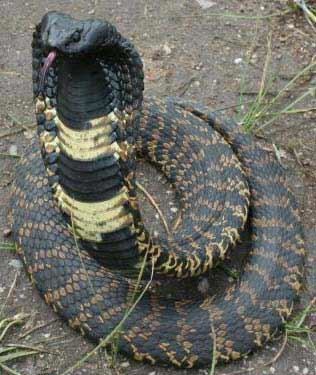Suborder Serpentes Scientific name Hemachatus haemachatus Higher classification Hemachatus Order Scaled reptiles | Subphylum Vertebrata Phylum Chordata Rank Species | |
 | ||
Genus HemachatusFleming, 1822 Similar Mozambique spitting cobra, Cape cobra, Black‑necked spitting cobra, Snouted cobra, Bitis arietans | ||
Releasing a rinkhals
The rinkhals (Hemachatus haemachatus), also called the ringhals or ring-necked spitting cobra, is a species of venomous elapid found in parts of southern Africa. It is not a true cobra in that it does not belong to the genus Naja, but instead belongs to the monotypic genus Hemachatus. It is closely related to the true cobras.
Contents
- Releasing a rinkhals
- The rinkhals doing it s thing
- Description
- Scale pattern and distribution
- Distribution
- Behaviour and diet
- Venom
- Symptoms of a bite
- Defensive behaviour
- Habitat
- References
The rinkhals doing it s thing
Description
Coloration varies throughout its distribution area, but a characteristic of the species is the belly is dark with one or two light-coloured crossbands on the throat. Their average length is 90–110 cm. Some individuals may have a mostly black body, while others are striped. Rinkhals scales are distinct from those of true cobras in that they are ridged and keel-like.
Scale pattern and distribution
Scalation:
Distribution
This species is found in the Southern Cape province of South Africa, northeast through the Free State, Lesotho, Transkei, Kwazulu Natal, South Africa, Western Swaziland, Mpumalanga and parts of Gauteng, South Africa. An isolated population is centered on Inyanga on the Zimbabwe-Mozambique border.
Behaviour and diet
The rinkhals has a varied diet. Its main prey is toads, but it also eats small mammals, amphibians, and other reptiles.
Rinkhals are unique amongst African cobras in being ovoviviparous. They give birth to 20–35 young, but as many as 65 young have been recorded.
Venom
The venom of the rinkhals is neurotoxic and partially cytotoxic, and is less viscous than that of other African elapids. When confronting a human, it generally aims its venom at the face. If the venom enters the eyes, it causes great pain.
A polyvalent antivenom is currently being developed by the Universidad de Costa Rica's Instituto Clodomiro Picado
Symptoms of a bite
Local symptoms of swelling and bruising is reported in about 25% (a quarter) of cases. General symptoms of drowsiness, nausea, vomiting, violent abdominal pain, cramps and vertigo often occur, as does a mild pyrexial reaction.
Defensive behaviour
If distressed, the rinkhals spreads its hood, showing its distinctive, striped neck. It is a spitting snake, and can spray its venom up to 2.5 m. Its spitting mechanism is primitive and it has to rear up and fling its body forward to spray its venom. It is also known to fake death by rolling onto its back with its mouth agape.
Habitat
The rinkhals generally prefers grassland habitats because it allows them to blend in with the surroundings. Rinkhals also may live in swamps around southern Africa.
